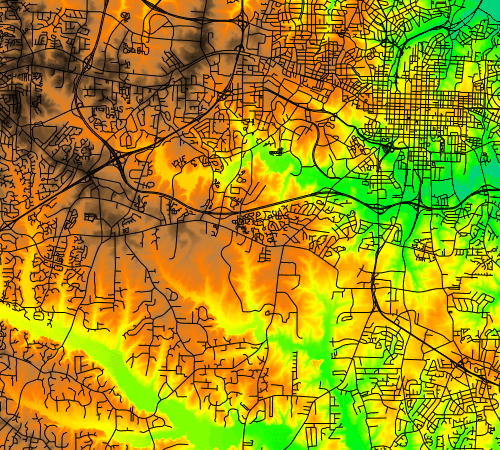Interfaces overview
GRASS provides a number of interfaces for interacting with the software. The most common interfaces are command line, Python, Jupyter Notebooks, and graphical user interface.
Command line
The command line, also know as terminal or shell, interface allows you to start a GRASS session to run GRASS commands, execute scripts, or open the graphical user interface.
Here we create a new project for the NAD83(HARN)/North Carolina coordinate reference system (EPSG:3358) and start a GRASS session as a new shell in your terminal:
grass -c EPSG:3358 {project directory} --text
The shell can now execute GRASS commands.
g.region raster=elevation
r.slope.aspect elevation=elevation slope=slope aspect=aspect
Python
GRASS Python interface provides libraries to use GRASS tools, create scripts, and access the GRASS data structures. The Python interface consists of three main libraries: grass.tools provides a Python interface to GRASS tools, grass.script handles GRASS projects and sessions in Python, and grass.pygrass enables a fine-grained access to the GRASS data structures.
To get started with scripting, create a new project with gs.create_project and
start a GRASS session with the gs.setup.init function to initialize the
GRASS environment.
import sys
import subprocess
# Append GRASS to the python system path
sys.path.append(
subprocess.check_output(["grass", "--config", "python_path"], text=True).strip()
)
import grass.script as gs
from grass.tools import Tools
# Create a new project
gs.create_project(path="path/to/my_project", epsg="3358")
# Initialize the GRASS session
with gs.setup.init("path/to/my_project") as session:
# Run GRASS tools
tools = Tools(session=session)
tools.r_import_(input="/path/to/elevation.tif", output="elevation")
tools.g_region(raster="elevation")
tools.r_slope_aspect(elevation="elevation", slope="slope")
Jupyter notebooks
Jupyter notebooks provide an interactive environment for writing and running code, combining text, code, and visualizations in a single document. They are widely used for data analysis, workflow prototyping, and scientific computing, making them a powerful tool for working with GRASS.
The grass.jupyter Python package provides a Jupyter
notebook interface to GRASS. It includes modules for creating map figures,
interactive web maps, visualizing data series and time series, and generating
3D visualizations.
To get started with grass.jupyter, import the package,
and start a GRASS session with the gj.init function:
import grass.jupyter as gj
session = gj.init("path/to/my_project")
All classes and functions for interaction in notebooks are now available under gj,
for example we can display a map with a selected raster and vector:
# Create a new map
m = gj.Map()
# Add a raster map to the map object
m.d_rast(map="elevation")
# Add a vector map to the map object
m.d_vect(map="streets", color="black")
# Display the map
m.show()
Desktop graphical user interface
The GRASS Desktop GUI is a graphical user interface for GRASS. Designed for efficiency and ease of use, it provides an intuitive way to interact with spatial data and the powerful tools available in GRASS. The GUI supports the visualisation of spatial data, the execution of geoprocessing tasks and the management of complex workflows.
SOURCE CODE
Available at: interfaces_overview source code
(history)
Latest change: Saturday Dec 13 14:38:00 2025 in commit 2525873

